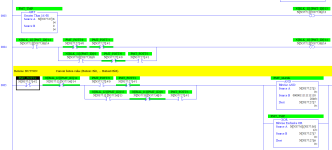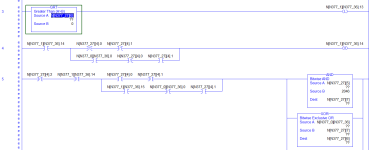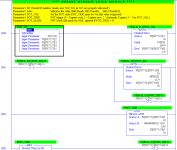mylespetro
Member
Hey everyone,
Just used the PLC5/Logix migration utility to convert a program, and while addressing the PCEs, I noticed a lot of errors for "XIC (or XIO), Operand 0: Invalid expression or tag." When I clicked on it, it brought me to a section of the program where there are about a dozen instances of double indirect addressing (not sure if that's the right term or not, but it's the best I can think of ). For instance, in the original PLC5 program, one instance is addressed as N[N377:1]:[N377:36].14, while in the converted Logix program it's addressed as N[N377_1][N377_36].14, which understandably doesn't work. For reference, the values evaluate to N[21]:[49].14 in the PLC5 and N[21][49].14 in the Logix program.
). For instance, in the original PLC5 program, one instance is addressed as N[N377:1]:[N377:36].14, while in the converted Logix program it's addressed as N[N377_1][N377_36].14, which understandably doesn't work. For reference, the values evaluate to N[21]:[49].14 in the PLC5 and N[21][49].14 in the Logix program.
I understand why this doesn't work on the Logix side, and have found a couple really good threads of people having the same (or similar) issue, and gather that the solution is probably to utilize two-dimensional arrays, but I'm having a little trouble wrapping my head around the actual implementation of it. I'm assuming that if I set it up correctly, instead of N[N377_1][N377_36].14 or N[21][49].14, I would have N[21,49].14, but there was mention of setting up intermediate DINT tags as two-dimensional arrays and using MOV instructions and I was just looking for a bit of clarification on the actual procedure of utilizing dimensional arrays to properly convert the PLC5 addressing to Logix addressing. I'll try to get some screenshots of both programs and post them here.
Thanks in advance
Just used the PLC5/Logix migration utility to convert a program, and while addressing the PCEs, I noticed a lot of errors for "XIC (or XIO), Operand 0: Invalid expression or tag." When I clicked on it, it brought me to a section of the program where there are about a dozen instances of double indirect addressing (not sure if that's the right term or not, but it's the best I can think of
I understand why this doesn't work on the Logix side, and have found a couple really good threads of people having the same (or similar) issue, and gather that the solution is probably to utilize two-dimensional arrays, but I'm having a little trouble wrapping my head around the actual implementation of it. I'm assuming that if I set it up correctly, instead of N[N377_1][N377_36].14 or N[21][49].14, I would have N[21,49].14, but there was mention of setting up intermediate DINT tags as two-dimensional arrays and using MOV instructions and I was just looking for a bit of clarification on the actual procedure of utilizing dimensional arrays to properly convert the PLC5 addressing to Logix addressing. I'll try to get some screenshots of both programs and post them here.
Thanks in advance






